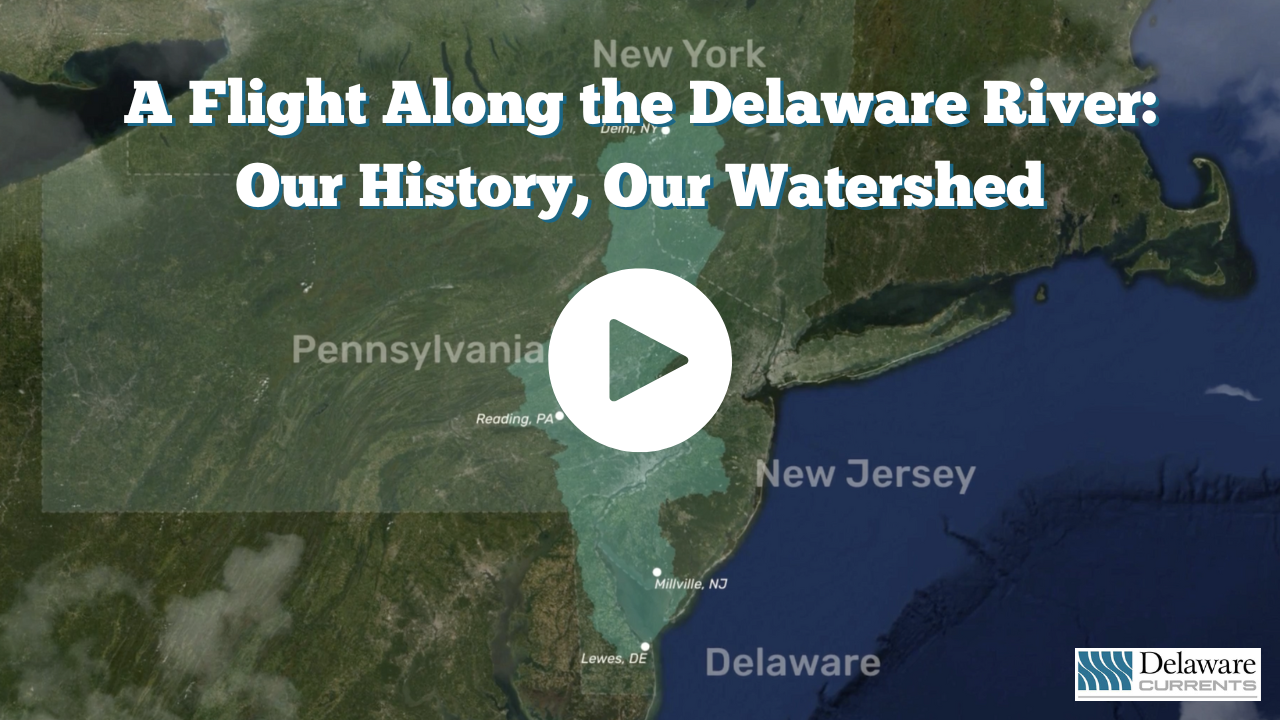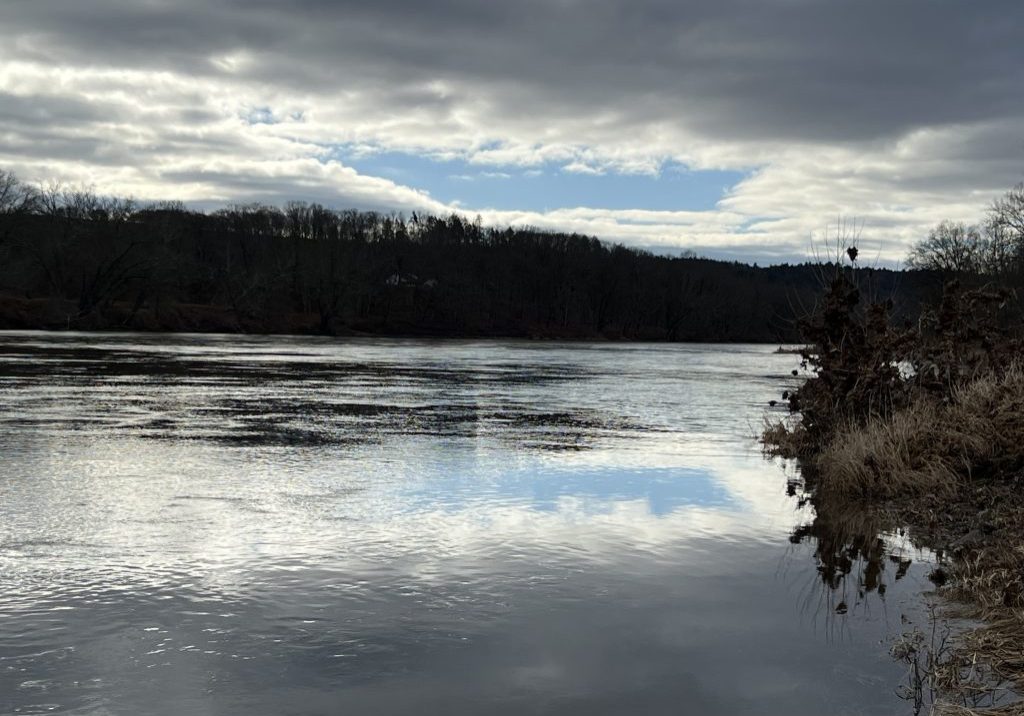
Racing to save Stone Harbor’s Scotch Bonnet Island before it’s swallowed by rising seas
| May 29, 2025
The Philadelphia Inquirer
This article originally appeared in The Philadelphia Inquirer and is shared via the Center for Cooperative Media at Montclair State College.
Lenore Tedesco doesn’t need to venture far to witness sea-level rise. She tracks its relentless advance from her window at work.
Tedesco, executive director of the Wetlands Institute in Stone Harbor, stood by the nonprofit’s large conference room window in late May, surveying an expanse of salt marsh known as Scotch Bonnet Island. It was a idyllic Jersey Shore scene: osprey hovering over thousands of acres of spartina grass rippling in the breeze.
But over the years, her view has transformed into something more unsettling. Once-solid marshland has been fractured by new channels of encroaching water.
“These open water areas used to be marsh,” Tedesco said, gesturing out toward the grass. “It’s marsh that converted to mudflats and open water. All this open water you see was once grassy.”
It’s similar to what is happening one hour north by car in Atlantic County, at the Rutgers University Marine Field Station in Tuckerton, where the surrounding wetlands are also disappearing as flooding becomes more common.
Scientists say that saving marshland is imperative because it provides food, refuge, and habitat for three-quarters of shore birds; filters water and removes contaminants; and protects communities from storm surge.
Scotch Bonnet Island is being swallowed along with New Jersey’s other tidal wetlands. Small squiggly channels of water have begun to merge, forming wider pools. Scotch Bonnet Channel, a waterway that cuts through the bay to connect the barrier island to the mainland, has widened by 70 feet since 1970.
New Jersey literally loses a chunk of itself as more open water appears.
‘Increasing frequency of flooding’
Tedesco, who holds a Ph.D. in marine geology and geophysics, explains that sea-level rise is outpacing the marsh’s natural ability to regenerate after being flooded, part of the tidal cycle of the Jersey Shore.
Scientists say sea-level rise in New Jersey is running at twice the global average. They estimate the sea could rise two to five feet along the coast by 2100. That is sobering news given that New Jersey has 200,000 acres of tidal wetlands, valuable habitat used by shore birds and other wildlife.
“The increasing frequency of flooding is causing nesting failures and declines in bird populations,” Tedesco said.
Under Tedesco, the Wetlands Institute joined in 2024 with the U.S. Army Corps of Engineers and the New Jersey Department of Environmental Protection Division of Fish and Wildlife to raise about five acres of Scotch Bonnet Island with sediment.
The state and the Army Corps have been experimenting elsewhere with trying to stave off the loss by bringing in soil dredged from nearby channels and dumping it onto wetlands to raise them as part of the Seven Mile Island Innovation Laboratory, an initiative that began in 2019 to advance marsh restoration through new dredging techniques.
Sturgeon Island and Gull Island have also been raised within the Seven Mile Island Innovation Laboratory’s perimeter.
Scotch Bonnet Island, off Stone Harbor Boulevard in Cape May County along the Intracoastal Waterway, is one of the “islands” of marshland along the coast connected by channels. It sits within the nearly 18,000-acre Cape May Coastal Wetlands Wildlife Management Area, which is managed by the DEP’s fish and wildlife division.
The 86-acre island has lost more than one-third of its acreage since 1941, according to the Army Corps, and the pace of loss is quickening. Partners in the project, along with scientists at the University of Pennsylvania, predict another one-third could be lost by 2050.
In addition to rising seas, the area’s history of dikes from salt hay farms has altered water flow, exacerbating the issue. Overdevelopment hasn’t helped.
‘Negative feedback loop’
Tidal wetlands naturally replenish as sediment and organic matter get deposited during normal tidal cycles and flooding. But the tides have gotten higher and the flooding has worsened.
The marshes cannot keep up and convert first to low marsh, then to mudflats, and finally to pools of open water. As the pools expand, they connect to tidal creeks that remove more sediment from the marsh system, further accelerating loss.
Tedesco calls it a “negative feedback loop.”
The effort to raise Scotch Bonnet Island began in October as crews created a protective ring of coconut fiber logs to surround a spot of marsh. An Army Corps contractor took dredged sand and silt from the Intracoastal Waterway and pumped an estimated 25,000 cubic yards onto the island.
The project raised the land between two and 4.2 feet, which should be enough to stave off land loss for two decades without further help. The raised area is now a bald patch of dirt. Tedesco said she can see spurts of vegetation and birds returning to the location.
Tyler Kinney, a project manager for the Division of Fish and Wildlife, said it would take a few years for vegetation to once again cover the restored part of Scotch Bonnet Island.
“You have a natural seed source surrounding it,” Kinney said, referring to Spartina alterniflora, sometimes referred to as cordgrass. “You really don’t need to plant. That spartina is catching the seeds coming off the marsh, and it’s starting to already recolonize. In two to three years, it will start to look like the rest of the marsh.”
Kinney estimates that, so far, the lab has helped raise 100 acres of marsh within the Cape May Coastal Wetlands Wildlife Management Area and about 300 acres along the coastal region.
Sediment to raise the land comes from dredging performed to keep channels navigable. It has to be tested first to see whether it is free of contaminants. But scientists say there simply is not enough clean sediment available to raise all of New Jersey’s threatened wetlands.
‘A precipitous loss’
Scotch Bonnet Island is part of a larger effort to save tidal wetlands.
LeeAnn Haaf, a scientist with the nonprofit Partnership for the Delaware Estuary, estimates about one-fifth of the state wetlands are no longer keeping pace with sea-level rise.
“We’re approaching a threshold that a lot of scientists and researchers … are worried about,” Haaf said. ”If we reach a certain point of sea-level rise acceleration, we might actually start seeing a precipitous loss. We’re not there yet.“
Haaf is part of the New Jersey Tidal Wetland Monitoring Network, launched in 2019. The network includes 15 partners, including universities and nonprofits. The network has installed surface elevation tables, which are portable devices designed to measure elevation changes, and launched a website and mapping tool to display its work.
“SETs allow us to measure a really fine-scale variation down to the millimeter,” Haaf said. “And that’s really important for tidal wetlands.”
Kirk Raper, a DEP researcher, said the network has about 245 SET locations, with data for some going back to 2011. “This is a sort of first look at assessing the statewide implications,” Raper said.
The DEP estimates 61 percent of the state’s coastal wetlands might be vulnerable.
Joshua Moody, another DEP scientist, said getting the partners assembled, SETs installed, and “bringing all the data together” was a “huge hill to climb.” Now, he said, scientists can truly begin to track the decline of the state’s wetlands.
Metthea Yepsen, a DEP bureau chief, called wetlands restoration projects like Scotch Bonnet Island “a learning process” and said that they appear to be working, but that it is too early to assess the impact.
“When you place a lot of sediment on a marsh, it’s inherently disruptive. We see vegetation and animals that use the space either die or migrate off the site,” Yepsen said. “It is a slow process as it revegetates and the animals come back. But we’re learning a lot.”







